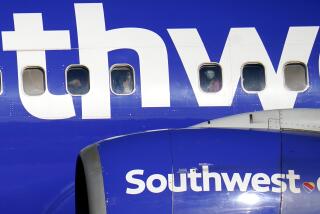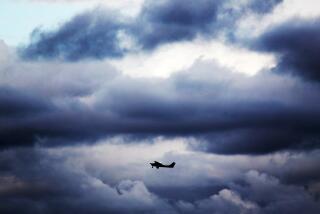Proposals About Going Up in Smoke
Get out your score cards.
Fifteen months after the United States and Canada banned smoking on airline flights lasting two hours or less, Congress is considering legislation that would either continue the existing rule or extend that ban to all flights, regardless of duration.
Here are the bills under study by the House Aviation Subcommittee:
--H.R. 160, sponsored by Congressman Richard J. Durbin (D-Ill.), would make permanent the smoking ban on commercial airline flights of two hours or less. The rule is scheduled to expire next April.
--H.R. 561, sponsored by Congressman Robert G. Torricelli (D-N.J.), would ban smoking on all domestic commercial airline flights.
--H.R. 598, introduced by Congressman James L. Oberstar (D-Minn.), would prohibit smoking on any scheduled airline flight in intrastate, interstate or overseas transportation.
--H.R. 817, introduced by Congressman James H. Scheuer (D-N.Y.), would extend the smoking ban on domestic flights of two hours or less and extend the ban to longer-duration flights (up to four hours) in 1991.
Terminal Ban
In addition, Sens. Ted Kennedy (D-Mass.) and Orrin Hatch (R-Utah) have introduced legislation that would provide a ban on smoking inside passenger terminals.
Why all the legislative activity?
Pro-smoking and anti-smoking forces have been battling each other for years, but nowhere is the war hotter than inside an airplane.
The anti-smoking groups, encouraged by the original two-hour ban, are gearing up for the bigger fight: the total ban on smoking on airplanes.
While the two-hour ban covers about 80% of all flights, it only affects 63% of all passengers. That leaves an increasingly more vocal 37%.
“If smoking on relatively short airline flights is a health hazard to passengers and crews, isn’t it even more dangerous on longer domestic flights?” asks Ahron Leichtman, president of Citizens Against Tobacco Smoke, a national nonprofit coalition of anti-smoking groups.
It may be a rhetorical question. A National Cancer Institute study, published earlier this year, indicated that nonsmokers traveling long distances on airplanes may inhale as much smoke in the nonsmoking section as in the seats allocated for smokers.
Danger to Crew
The smoking problem may be even more dangerous for flight attendants. Researchers at the University of Utah School of Medicine studied the impact of smoking in the workplace. They reported that women who were exposed to passive smoke for at least three hours a day were nearly three times as likely to get cervical cancer as those not exposed to passive smoke.
These medical findings are some of the reasons behind the proposed legislation. Another contributing factor is that the law prohibiting smoking on flights of two hours or less has loopholes and inconsistencies.
Some flights between cities permit smoking, while other nonstops between the same two cities are designated as nonsmoking. Congress, in drafting the current law, dealt with time, not mileage.
Another reason is the growing anti-smoking lobby that’s building among the ranks of flight attendants. Airline cabins are the workplace for more than 90,000 flight attendants, who on average spend more than 900 hours each year working in the airline cabin, often a hazardous environment filled with the toxic and harmful chemicals contained in tobacco smoke.
Legal Liability
“This raises a legal question,” Leichtman said, “and involves corporate legal liability, especially when the airlines are paying workers’ compensation claims filed by flight attendants who have become ill and/or suffered disease from exposure to tobacco smoke.”
Leichtman points to a recent study by Dr. Alan R. Kahn, a pilot, physician and ex-Air Force flight surgeon.
“It indicates that flight crews who work in the smoking sections experience a loss of oxygen saturation in their blood and may be at risk, since some describe instances of dizziness and nausea when they work in smoking sections,” he said. “Pilots are also affected by low blood-oxygen saturations.
“There’s ample evidence that oxygen saturation values are low enough when tobacco smoke is present to significantly reduce a person’s ability to exercise good judgment. Safety, therefore, becomes a factor.”
Another study of airline pilots showed that 63% of nonsmoking pilots in the study of 1,287 airline pilots responded “yes” to the question: “Does the commonly attained level of tobacco smoke in the cockpit impair your ability to perform your duties?”
Safety Factors
Two out of three nonsmoking pilots said smoking in the cockpit is detrimental to crew coordination and/or air safety, and 82% said smoking in the cockpit of aircraft should be prohibited or restricted. (The cockpit is not affected by the two-hour airline smoking law, but would be affected by the proposed Hatch-Kennedy bill.)
Some airlines already are reaping benefits from taking a strong stand against smoking aboard their aircraft.
Northwest Airlines was the first (and remains the only) U.S. airline to voluntarily extend the ban to all of its U.S. flights, regardless of duration.
“It’s been an overwhelming success, and passenger support has been very, very strong,” said Kevin Whalen, Northwest spokesman. “In fact, not only hasn’t our market share been reduced because of our decision, there is some evidence to indicate it has been increased because of it.”
Canadian Airlines International and Air Canada have expanded the smoking ban to all of their North American flights--again, with great passenger support. Two other countries (where flights can be very long) have also imposed extended bans: Australia and the Soviet Union.
To be sure, the smoking bans are popular with passengers. A recent survey conducted by the American Assn. for Respiratory Care showed that an overwhelming 84% of those surveyed approved the smoking ban. In the same survey, even 58.1% of all smokers supported it.
More to Read
Get the L.A. Times Politics newsletter
Deeply reported insights into legislation, politics and policy from Sacramento, Washington and beyond. In your inbox three times per week.
You may occasionally receive promotional content from the Los Angeles Times.










